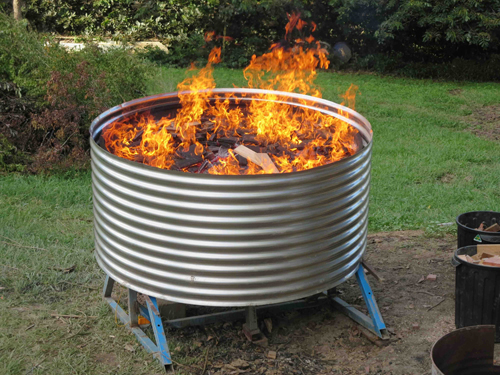Kon-Tiki Kiln: Difference between revisions
(embedded video) |
m (minor edits; inserted link: "Charmaking in the Himalayas" (The Biochar Journal)) |
||
| Line 3: | Line 3: | ||
Excellent open source pyrolysis kiln from Switzerland for [[biochar]] production with a very clean burn. Some implements are already available and everything is open source. | Excellent open source pyrolysis kiln from Switzerland for [[biochar]] production with a very clean burn. Some implements are already available and everything is open source. | ||
Ithaka Institut says: ''While most of the biochar produced during the last 5000 years was produced with open fire, modern pyrolysis suppresses the fire. The separation of the carbonisation and the flaming of the pyrolysis gases make pyrolysis technology prone to failure and expensive which is one of the reasons why the biochar technology did not have yet it's breakthrough. The Kon-Tiki flame curtain kiln re-connects biochar making to the ancient wisdom and craft of fire making and combines it with smart design based on modern thermodynamics to produce high quality char with low emissions.'' | Ithaka Institut says: ''While most of the [[biochar]] produced during the last 5000 years was produced with open fire, modern pyrolysis suppresses the fire. The separation of the carbonisation and the flaming of the pyrolysis gases make pyrolysis technology prone to failure and expensive which is one of the reasons why the biochar technology did not have yet it's breakthrough. The Kon-Tiki flame curtain kiln re-connects biochar making to the ancient wisdom and craft of fire making and combines it with smart design based on modern thermodynamics to produce high quality char with low emissions.'' | ||
My (Rasmus) opinion: these types of open-burn kilns appear to have some advantages over those "barrel-in-a-barrel" retorts that were advocated in the past. This does away with a metal barrier | My (Rasmus) opinion: these types of open-burn kilns appear to have some advantages over those "barrel-in-a-barrel" retorts that were advocated in the past. The char produced with open burn kilns may be of higher quality. This kiln does away with a metal barrier which is costly, labor-intensive to make, and corrodes easily. | ||
==Video== | ==Video== | ||
| Line 16: | Line 16: | ||
*[http://www.ithaka-institut.org/en/ct/101 More videos from Ithaka Institut] | *[http://www.ithaka-institut.org/en/ct/101 More videos from Ithaka Institut] | ||
*[http://www.ithaka-institut.org/ithaka/media/doc/kon-tiki-presentation.pdf Ithaka Inst.: "Download the presentation of the Kon-Tiki technology" (.pdf)] | *[http://www.ithaka-institut.org/ithaka/media/doc/kon-tiki-presentation.pdf Ithaka Inst.: "Download the presentation of the Kon-Tiki technology" (.pdf)] | ||
* [https://www.biochar-journal.org/en/ct/46 "Charmaking in the Himalayas"] (The Biochar Journal) - has picture of full-scale “flat pack” 1000 liter Kon-Tiki | |||
Revision as of 00:18, 9 March 2016
Excellent open source pyrolysis kiln from Switzerland for biochar production with a very clean burn. Some implements are already available and everything is open source.
Ithaka Institut says: While most of the biochar produced during the last 5000 years was produced with open fire, modern pyrolysis suppresses the fire. The separation of the carbonisation and the flaming of the pyrolysis gases make pyrolysis technology prone to failure and expensive which is one of the reasons why the biochar technology did not have yet it's breakthrough. The Kon-Tiki flame curtain kiln re-connects biochar making to the ancient wisdom and craft of fire making and combines it with smart design based on modern thermodynamics to produce high quality char with low emissions.
My (Rasmus) opinion: these types of open-burn kilns appear to have some advantages over those "barrel-in-a-barrel" retorts that were advocated in the past. The char produced with open burn kilns may be of higher quality. This kiln does away with a metal barrier which is costly, labor-intensive to make, and corrodes easily.
Video
Links
- "Kon-Tiki - the democratization of biochar production" (The Biochar Jourrnal) (read this! - internal copy here)
- More videos from Ithaka Institut
- Ithaka Inst.: "Download the presentation of the Kon-Tiki technology" (.pdf)
- "Charmaking in the Himalayas" (The Biochar Journal) - has picture of full-scale “flat pack” 1000 liter Kon-Tiki
